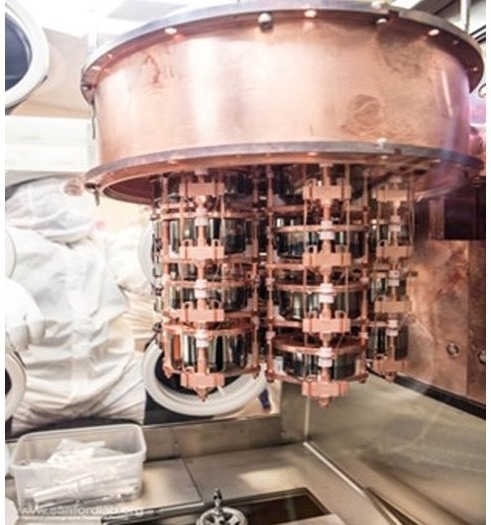Reviewed by Lexie CornerMay 7 2024
A recent publication in the journal Physical Review Letters unveiled that researchers at the Sanford Underground Research Facility, a Department of Energy Office of Science user facility, conducted a search for dark matter particles using a highly sensitive detector deployed deep underground. Despite their efforts, no signal indicating the presence of dark matter was detected.
 Final assembly of germanium radiation detectors for the Majorana Demonstrator in 2015. These detectors produced a low-background, “quiet” data set that researchers used to search for signs of dark matter and other physics beyond the Standard Model. Image Credit: Matthew Kapust, Sanford Underground Research Facility.
Final assembly of germanium radiation detectors for the Majorana Demonstrator in 2015. These detectors produced a low-background, “quiet” data set that researchers used to search for signs of dark matter and other physics beyond the Standard Model. Image Credit: Matthew Kapust, Sanford Underground Research Facility.
The observation that dark matter affects the velocity of stars and galaxies provides scientific proof for its existence. Scientists believe particles may make up dark matter. Physicists have utilized some of the largest and most sensitive tests ever constructed to find these particles and their billiard-ball-like collisions.
However, these investigations have yet to detect any dark matter signals. According to scientific predictions, dark matter particles should interact very weakly. This implies that when the Earth travels through dark matter and collides with a tiny fraction of the particles, detectors on Earth should be able to detect a “wind” in dark matter particles.
A further possibility is that the dark matter may be completely absorbed in the event of an extremely unusual collision, producing a very little energy burst.
Radiation detectors susceptible to this kind of interaction include the Majorana Demonstrator. The experiment's detectors are incredibly sensitive to even tiny energy shocks because they are located deep underground and protected from outside radiation sources like cosmic rays.
Compared to similar detectors, these qualities allowed scientists to conduct a five to ten times more sensitive search. The researchers did not find the anticipated signal from dark matter. This enables researchers to revise the upper bounds on the potential mass of dark matter in various scenarios.
These results will probably stay within the best limits with this specific detection technology.
The Impact
Scientists' knowledge of the cosmos would be drastically altered if they could determine the nature and origin of dark matter. Dark matter signals should be detectable with low-background radiation detectors, according to many theoretical models of the material.
Scientists using the Majorana Demonstrator experiment have drastically restricted the characteristics of potential dark matter particles, as they searched for specific forms of dark matter and found no signal. Despite not finding dark matter directly, the study employed a methodology that can influence further research.
Summary
Researchers in this study searched for multiple forms of dark matter using an advanced experimental setup with high-purity germanium detectors. Still, they could not uncover any meaningful signal consistent with the predictions of multiple theoretical models.
The experiment was conducted in concert with several institutions and laboratories, resulting in a large-scale, multidisciplinary endeavor.
The research focused on searching for different kinds of enigmatic dark matter possibilities, including fermionic and bosonic dark matter, as well as sterile neutrinos. The detection of dark matter would offer a significant understanding of the universe's composition and mechanics beyond the Standard Model.
The study also confirms the remarkable sensitivity and wide applicability of the Majorana Demonstrator experiment to several physics domains. The Majorana Demonstrator data collection has been utilized as the foundation for numerous significant scientific projects.
The Department of Energy (DOE) Office of Science and the Office of Nuclear Physics supported this work.
Additionally, the research received funding from the National Science Foundation’s Particle Astrophysics Program and Nuclear Physics Program. Further support was provided by the South Dakota Board of Regents Competitive Research Grant, the Laboratory Directed Research & Development programs at Lawrence Berkeley National Laboratory and Los Alamos National Laboratory, the Natural Sciences and Engineering Research Council of Canada, and the Canada Foundation for Innovation John R. Evans Leaders Fund.
The research utilized resources provided by the Oak Ridge Leadership Computing Facility at Oak Ridge National Laboratory and the National Energy Research Scientific Computing Center, both DOE Office of Science user facilities.
Journal Reference:
Arnquist, I. J., et al. (2024) Exotic Dark Matter Search with the Majorana Demonstrator. Physical Review Letters. doi.org/10.1103/PhysRevLett.132.041001.